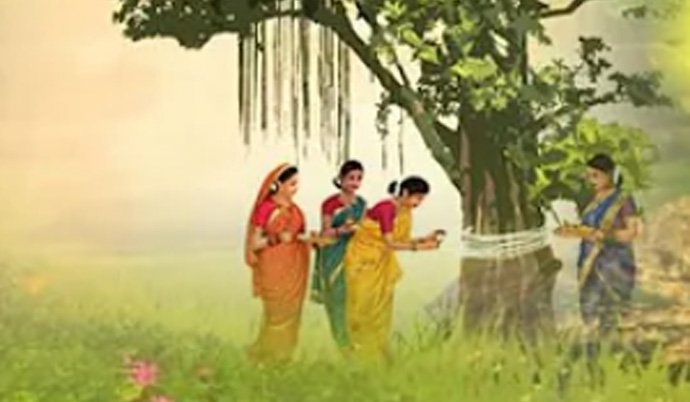In Sanatan Dharma, every Teej festival and fast holds significant spiritual importance. One such revered observance is the Vat Savitri fast. Married women undertake this fast for the longevity, happiness, and prosperity of their husbands. The fast is deeply rooted in the belief that observing it brings blessings to the family, enhancing good fortune and marital bliss. The components of this fast, namely ‘Vat’ (the Banyan tree) and ‘Savitri’, are imbued with special importance. Similar to the Peepal tree, the Banyan tree holds a sacred place in Hindu rituals. Today, we delve into the various aspects of the Vat Savitri fast and its profound significance.
The Importance of Vat Savitri Fast
Observing the Fast for the Husband’s Longevity
The Vat Savitri fast is primarily observed for the long life and well-being of the husband. It holds a crucial role in the lives of married women, symbolizing their dedication and love. This fast is observed on the Amavasya date of Krishna Paksha of Jyeshtha month. On this day, married women partake in fasting and perform rituals under the Banyan tree to seek blessings for their husbands.
Rituals Under the Banyan Tree
The worship conducted under the Banyan tree on Vat Savitri holds immense spiritual significance. Women gather to perform rituals, invoking blessings for their husbands. The day is marked by narrating the story of Savitri and Satyavan, a tale symbolizing unwavering devotion and the power of a wife’s prayer.
When is Vat Savitri Vrat in 2024?
This year, the Vat Savitri Vrat will be observed on Thursday, 6th June. The date is chosen based on the lunar calendar, aligning with the Amavasya of Krishna Paksha in the month of Jyeshtha. This alignment ensures that the spiritual energy is at its peak, enhancing the efficacy of the prayers and rituals performed on this day.
Detailed Rituals and Puja Practices
Shodashopchar, Panchopchar, and Dashopchar Puja
To attain the most auspicious results, women can perform various forms of puja such as Shodashopchar (16-step), Panchopchar (5-step), and Dashopchar (10-step) puja under the Banyan tree. These rituals involve offering various items that symbolize respect and devotion.
Offering Makeup Materials
As part of the puja, women offer makeup materials (Saubhagya items) to the deity. This act symbolizes their wish for the longevity and prosperity of their husbands. Items such as bangles, sindoor (vermilion), and bindi are placed at the base of the Banyan tree during the ritual.
Giving Dakshina
Post the puja, it is customary for women to give Dakshina (donations) to a Brahmin as per their capacity. This act of charity is believed to enhance the spiritual benefits of the fast. It signifies a selfless offering, aiming to garner divine blessings.
The Story of Savitri and Satyavan
The Legend
The tale of Savitri and Satyavan is integral to the Vat Savitri fast. Savitri, the epitome of a devoted wife, is revered for her dedication and unwavering faith. According to the legend, Savitri’s prayers and determination brought her husband Satyavan back to life, overcoming the decree of Yama, the god of death. This story is narrated during the puja, inspiring women to channel similar devotion and faith in their prayers.
Symbolism and Belief
The story symbolizes the power of a devoted wife’s prayer and its ability to alter destiny. It reinforces the belief that true devotion and piety can transcend the barriers of mortality and fate, bringing about miraculous outcomes.
Significance of the Banyan Tree in Vat Savitri
Sacredness of the Banyan Tree
In Hindu tradition, the Banyan tree is revered for its longevity and vastness. It symbolizes eternal life due to its ever-expanding branches and roots. This tree is often associated with Yama, the god of death, and is believed to provide spiritual shelter and protection.
Rituals and Offerings
Worshiping the Banyan tree involves circling it and tying threads around its trunk, which symbolizes the unending bond of marriage. Women offer water, milk, flowers, and sacred threads to the tree. The act of tying threads around the tree is believed to bind the longevity and prosperity of their marital life to the tree’s eternal nature.
Preparation for Vat Savitri Fast
Early Morning Rituals
On the day of Vat Savitri, women wake up early, take a ritual bath, and dress in traditional attire, often choosing red sarees as red symbolizes auspiciousness and marital bliss. They adorn themselves with traditional jewelry and makeup, signifying their respect for the ritual.
Observing the Fast
The fast is observed throughout the day, with women abstaining from food and water in many cases. This act of penance is undertaken with the belief that such sacrifices will bring divine blessings upon their husbands.
The Vat Savitri fast is a testament to the enduring traditions and deep-seated beliefs in Hindu culture. It is a day of profound spiritual significance, where married women express their devotion and seek blessings for their husbands’ longevity and prosperity. The rituals performed under the sacred Banyan tree, the narration of Savitri’s unwavering devotion, and the observance of the fast all intertwine to create a day rich in tradition and faith. This year, as we approach 6th June, let us honor and uphold the sanctity of this age-old tradition, celebrating the strength and devotion of married women in their pursuit of a blessed marital life.
















